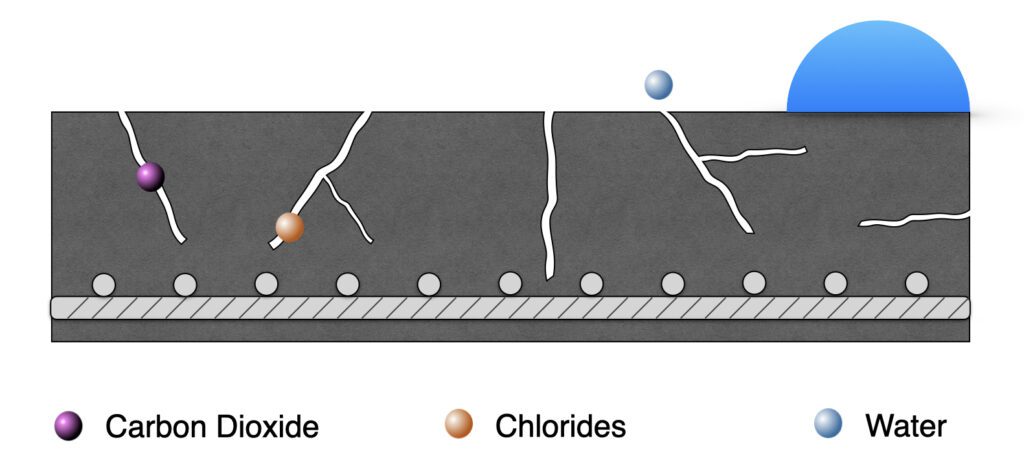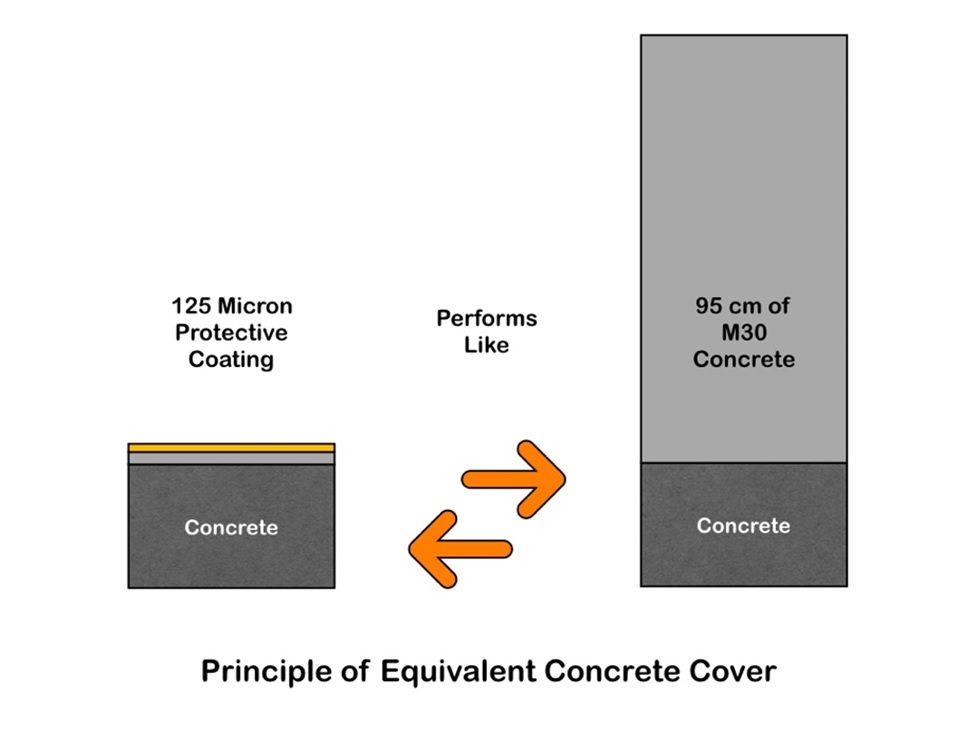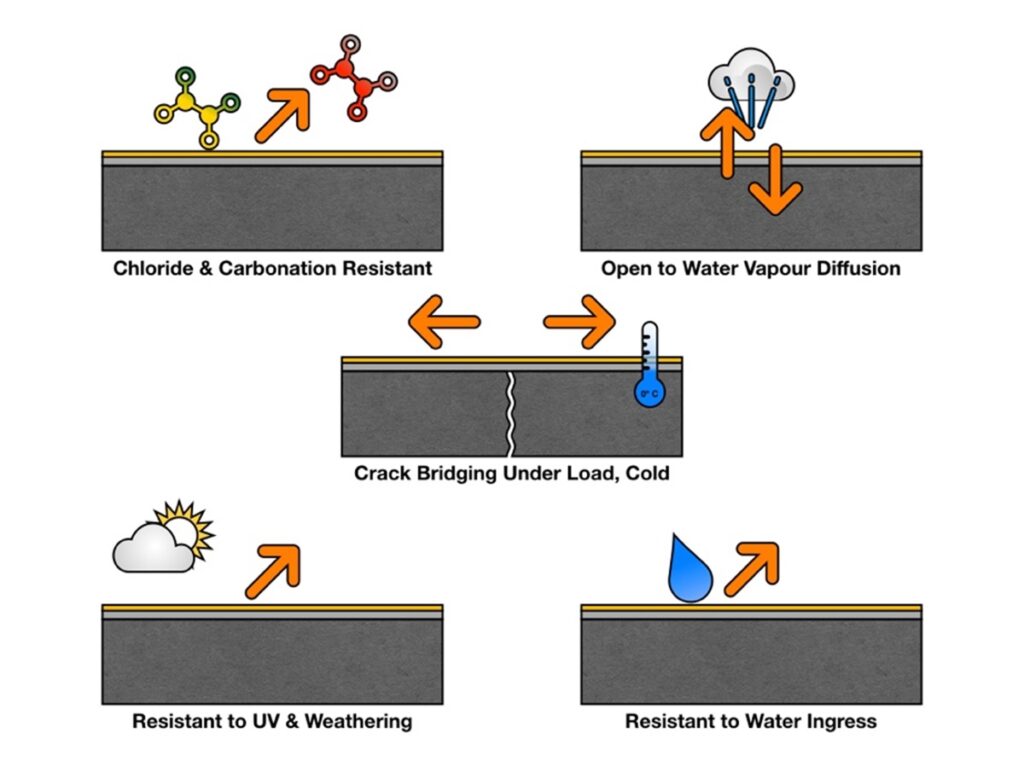Reinforced Cement Concrete is one of the most widely used materials in India today. The combination of concrete and reinforcing steel is a system built to work in unison, whereby the concrete provides the compressive strength, and the reinforcing steel provides the tensile & flexural strength. The reinforcement helps reduce cracking in concrete and the concrete in turn provides the reinforcement with passivation and resistance to corrosion.
RCC is said to be durable when it can withstand design exposure conditions, over its service life with little deterioration. Durability is a function of the quality and quantity of cover to the reinforcement. Even when we consider international codes for repair, restoration or maintenance of RCC Structures, such as EN – 1504, the materials that play a major role in maintaining the integrity of structures are protective coatings.
Considering construction practices and environmental conditions today, it becomes virtually impossible to cast specified cover in terms of quality and / or quantity. A combination of the porous nature of concrete and a weak cover, leads to diffusion of detrimental materials like water, CO2, chlorides and SO2 into concrete. This process leads to loss of passivity, corrosion of the steel and ultimately deterioration of the concrete.
Durability of concrete can be greatly enhanced by use of apt protective anti-carbonation coatings such as SS – ProtectoCon AC that can form a physical and a chemical barrier against ingress of water, chlorides, CO2 and SO2. Paints and other decorative coatings are designed for aesthetic purposes and normally not for protection of concrete against carbonation, chloride attack, UV radiations and for crack bridging properties. This system can be used to virtually protect any construction system including but not limited to:
- Residential Buildings
- Commercial Buildings [Malls, Hotels, Office Buildings]
- RCC Industrial Structures
- External faces of above ground water tanks and reservoirs
- Heritage structures
- Infrastructure [Bridges, Viaducts, above Ground Metro Lines, Flyovers, Underpasses, etc.]
THE PROCESS OF CORROSION OF REINFORCEMENT IN CONCRETE
Concrete is a non-homogenous material. The cover concrete has many non-visible micro cracks, which act as avenues for water or gas penetration. In hardened concrete, the pH values in the matrix reach about 12.5. Thus, the reinforcement in the concrete remains in a passive condition and does not corrode. Once water, chlorides, CO2 or SO2 enter the concrete, the process of depassivation occurs and corrosion begins. The change of concrete pH due to carbonation mechanism is given in Figure 1.

CORROSION PROTECTION BY USE OF ANTI-CARBONATION COATINGS
One can prevent corrosion, by providing the concrete with a cover both in terms of quality and quantity. This can be done by:
Principle 1: – Set up an additional concrete cover that is sufficient in density and thickness (like jacketing) OR
Principle 2: – Leave the cover as it is or set up a minimum required cover and apply a surface protection system.
Figure 2 shows both the principles. By virtue of their formulations, anti-carbonation protective coatings provide the protection quotient of meters of concrete cover in a very thin layer. Figure 3 shows equivalent cover / protection provided by SS – ProtectoCon AC. Therefore, the principle of equivalent cover is very valuable both in repair strategies and even to safeguard new structures that have a very long design life. Specialized protective coatings can be of many types:

- Thick Coatings (1-2mm): Like Different Breathable waterproof cementitious or mineral based polymer modified coatings or resin-based systems
- Breathable, Elastic Elastomeric Crack Bridging Anti-Carbonation coatings (200-300-micron thickness)
It is beneficial to incorporate protective coatings, from the design stage. Although the main function of any surface protectant is moisture ingress control, the coatings can also be designed for resisting chemicals, physical damage [abrasion, impact] or biological attacks and water. Chloride ingress can be effectively controlled by surface protectants. The diffusivity of carbon dioxide, sulphur dioxide and oxygen can be lowered. Root and vegetation growth can be prevented in concretes under damp conditions.

The challenge here is to choose the right coating for the right application. For e.g. Marine Structures, Wastewater Treatment Structures, wet areas in bathrooms and building construction, terraces, interior walls of water tanks, etc. call for thick protective coatings. Exposed Concrete Structures like bridges, power plants, fair face finished building walls, external faces of water tanks, etc. call for special anti-carbonation coatings such as SS – ProtectoCon AC.
PROPERTIES NEEDED IN COATINGS FOR CONCRETE IN GENERAL APPLICATIONS
The coatings to be applied on concrete should not be selected solely for aesthetics but also on protection criteria. It is possible to have both aesthetic and protection judiciously combined in a single well-designed coating. Figure 4 shows the properties and requirements of general protective coatings for concrete and cover the concrete protection solutions in the section above. According to international literature the following properties, are most essential for an excellent concrete protection system.
BREATHABILITY
It is a property which enables the water vapor to move in and more importantly out of the concrete with the fluctuation of temperature and humidity. The water in concrete (or for that matter any porous media) tends to go from wetter to drier sections. Breathability is essential because, moisture movement in concrete may lead to osmotic pressure building up under non-breathable coatings and eventual debonding of the protective coating. Breathability also enhances drying of the internal concrete, arresting corrosion. Modern anti-carbonation elastic elastomeric coatings, provide a high breathing capacity as compared to most resin-based coatings, and thus can protect structures longer.

IMPERMEABILITY TO WATER, CO2 AND OTHER GASES
Protective coatings should be permeable to water vapor, but impermeable to water. Though these properties look contradictory they must exist complimentarily. Most coatings possess waterproofing characteristics but are not breathable. This is the balancing point separating modern anti-carbonation protective coatings like SS – ProtectoCon AC from normal paints. In addition to water, it prevents ingress of corrosion causing gases into the concrete.
CRACK BRIDGING
This is an important property as the coating should be able to negotiate expansions and contractions in the structure due to temperature or dynamic loads. It should also effectively seal and bridge over cracks, to ensure no water or gases enter concrete through them. Even after extensive weathering, protective coatings should provide excellent crack bridging capacities in a variety of static or dynamic loading conditions, in varying exposure conditions and even on weathered concrete surfaces.
ULTRAVIOLET (UV) RAYS RESISTANCE
For exterior application it is mandatory that the coatings should be UV stable. The effect of sunlight can cause certain polymers to become brittle and lose their physical and chemical properties. Exposure to sun can also leads to fading of pigments and differential colouring marring the beauty of the structures. Correctly designed protective coatings remain flexible even after exposure to sunlight without degrading.
SPECIFYING THE PROTECTIVE COATING
Rather than specifying coatings by generic names and film thickness it is preferable to specify them by performance requirements. Some performance properties that can be normally specified are:
- Diffusion resistance of CO2
- Diffusion resistance against H2O vapour, when designated as breathable coatings.
- Resistance against water penetration
- Resistance to chlorides (ponding)
- UV Resistance
- Crack Bridging ability under weathered conditions
First and foremost, the specifier must clearly understand the protection requirements. It is therefore definite that specification will change form project to project. Specifications should also depend upon the life span, durability and protective quotient with respect to time. Cost calculations must be time dependent. The specifier can refer to IRC SP 80 and Specifications for Road and Bridge Construction for Specifications on Anti-Carbonation coatings.
EVALUATION OF ANTI-CARBONATION PROTECTIVE COATINGS
SS – ProtectoCon AC has been evaluated for various properties as specified by IRC SP:80 and the MORTH Orange Book of Unified Specifications. As seen the material greatly surpasses the minimum performance requirements and based on this can provide very long lifespan of the coating itself and thereby of the structure it is protecting. The requirements by norms and the performance of SS – ProtectoCon AC is summarized in Table 1. In addition, the coating is tested for and has very low VOC, is water based, therefore making the material non-hazardous and environmentally friendly.
Table 1: Summary of codal requirements and performance of SS – ProtectoCon AC
| SR. NO | PARAMETER | REQUIREMENT | REFERENCE | SS – PROTECTOCON AC PERFORMANCE |
| 1 | UV RESISTANCE | No Colour Change after 400 hours exposure | ASTM G-53 / DIN EN 150-105 | No Colour Change / Passes |
| 2 | IR-SPECTRUM | Acrylic Polymer | IR Spectrometer Std. | Acrylic Polymer |
| 3 | ADHESION WITH CONCRETE | > 1.5 N / mm2 | ASTM D4541-02 / DIN 50014 | >> 1.5 N / mm2 |
| 4 | DIFFUSION RESISTANCE TO CO2 | Eq. Air Layer Thickness, SDCO2 > 50 m | DIN 53122 Part I | >> 50 m |
| 5 | DIFFUSION RESISTANCE TO H2O | Eq. Air Layer Thickness, SDH2O < 4 m | DIN 52615 | << 4 m |
| 6 | WATER PERMEABILITY OF COATING | w < 0.1 kg / m2 . h0.5 | EN 1062 – 3 – 2008 or Similar | << 0.1 kg / m2 . h0.5 |
| 7 | TENSILE STRENGTH | > 1.5 N / mm2 | ASTM D 638 | > 1.50 N / mm2 |
| 8 | ELONGATION | > 200% | ASTM D 638 | > 200% |
| 9 | SALT SPRAY TEST | No damage after 400 hours exposure | ASTM B 117 | No Damage |
| 10 | CRACK BRIDGING ABILITY | > 2.0 mm | ASTM C 1305 – 2008 | 2.5 mm |
CONCLUSION
Concrete or masonry structures need protection from the elements and chemically aggressive substances such as carbon dioxide, chlorides, salt laden atmosphere and most importantly water. We can now protect structures from these aggressive influences by using a long lasting, elastomeric, UV resistant, crack bridging, chloride, carbonation, and water resisting anti-carbonation coating such as SS – ProtectoCon AC. This coating has successfully been used on a variety of different structures such as residential and commercial buildings, bridges, powerplants, silos, hotels, factories, and heritage buildings such as churches and temples.
The versatility of this coating and its long life provides an effective protection for structures, from water and cracking. The fact that it can be tinted in various colours only adds to the beauty of structures and is a good cost-effective substitute to normal treatments.
The performance of SS – ProtectoCon AC has been proven by extensive laboratory testing and its on-site use. Please contact Assess Build Chem Private Limited to know more about the coating and other waterproofing and repair material systems to enhance the life of your structures.

